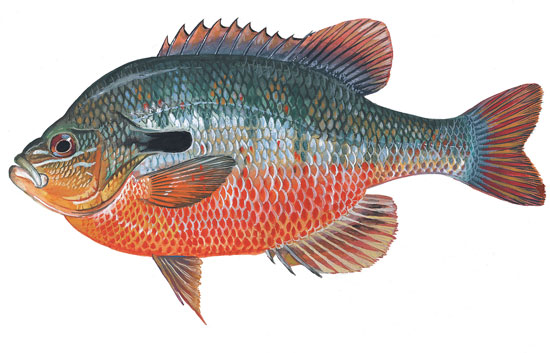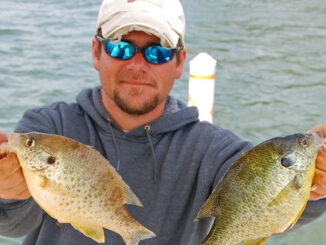
Brightly colored fish is tough fighter, great table fare
The redbreast sunfish is one of the most colorful panfish in the Carolinas. This species lives in both North and South Carolina. But it’s not found in as many places as its more populous cousin, the bluegill.
Unlike bluegills, redbreasts are rarely found in large lakes, or even ponds. They can live in these areas, but they prefer moving water. These fish are most often found in rivers, streams, and swamps that have current. They have the same basic shape of bluegills and other sunfishes, but are slightly longer than most of them.
One of the most distinguishing characteristics of redbreasts is the bright red or orange chest and belly. But this is less bright on some fish, depending on the body of water. Redbreasts in the Wateree River, for example, are more yellow than red. But in waters like Lynches River or the Lumber River, the colors are typically a much brighter red or orange.
Within the moving waters that redbreasts prefer to live, they can most often be found near downed trees, stumps, the undercuts of banks, rocky points, and collections of sunken or floating timber. They generally shy away from heavily vegetated areas.
Redbreast sunfish have much longer earflaps than other sunfish species
The truest way to distinguish redbreasts from other sunfishes is by taking a good look at the gill cover, or earflap, which extends far longer than the gill cover of any other sunfish, and it is always solid black.
The redbreast’s diet is mainly made up of insects, mollusks, and small minnows. They also love crawdads, and will pass up other opportunities if they know crawdads are available.
Like the other sunfish species, redbreasts typically spawn from May through July, but they can start sooner and continue later as long as the water temperature is between 65 degrees and 75 degrees. During spawning, males use their tails to fan out large circular nests in shallow water. These nests can be in singles, or in groups up to 100 or more. They are often built near, or even intermingled with nests of other sunfishes.
Redbreast sunfish have many regional nicknames
Other names that redbreasts are known by throughout different areas of the Carolinas include red belly, robin, long ear, and red bream. Inexperienced anglers often misidentify them as bluegills, pumpkinseeds, and shellcrackers.
Small spinners like Mepps Aglias, Johnson Beetlespins, Rebel Wee Craws and Crickhoppers are great lures. Crickets, waxworms, catalpa worms, small crawdads, and red wigglers are great baits, especially when used under small corks on ultralight rods and reels. Six-pound test line and No. 6 hooks with small split-shot weights are perfect to use on cane poles, fiberglass bream poles, or ultralight rods and reels.
While few people seem to fish for redbreasts after dark, they are known as the only sunfish that bites consistently throughout the night. So targeting them after sunset is an option.
The North Carolina state record redbreast is a 2-pound, 1-ounce fish. Alphonso Jackson of Maxton caught it on June 10, 2019 in the Lumber River. Jackson caught the fish on a cricket.
The South Carolina state record redbreast is 2 pounds, was caught by D.R. Turner in the South Carolina portion of the Lumber River in 1975.




